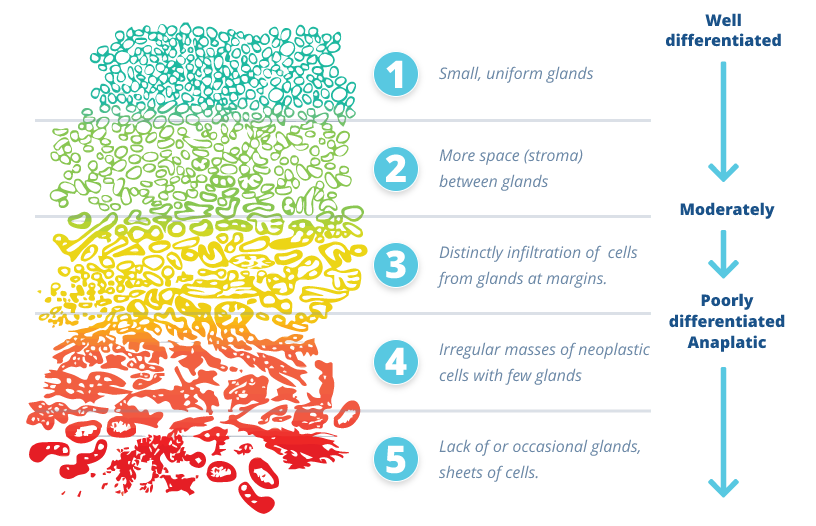Based on your family history and results of other diagnostic tests, your doctor may recommend taking a biopsy of your prostate to check for the presence and aggressiveness of cancer cells in your prostate.
Your doctor will use a hollow needle inserted either through the rectum or the perineum (skin between the anus and scrotum) to pull out small samples of prostate tissue called cores. Your biopsy samples will be sent to a lab for testing, where a pathologist will examine them under a microscope. If they find cancer cells in the samples, they will grade the aggressiveness of the cancer using a Gleason Score.
The Gleason Score is used to evaluate the aggressiveness of prostate cancer. Using samples from a prostate biopsy, the Gleason grading system determines whether cancer looks like healthy or abnormal tissue. The higher the Gleason score, the higher the chance that the cancer will spread quickly.
This grading system can be used to choose appropriate treatment options, along with other test results to estimate the risk for your cancer to spread, which will contribute to how you decide to manage your disease. The Gleason Score is typically combined with a set of other parameters to predict prognosis and guide treatment.
Malignant prostate tumors are made up of cancerous cells that have different grades. The Gleason score is calculated by adding the two most common grades – one primary grade and a secondary grade. The primary grade describes the largest area of the tumor while the secondary grade describes the next largest area.
The Gleason score is determined by adding the two most common grades. For example, the most common grade of the cells in a tissue sample may be grade 3 cells, followed by grade 4 cells. The Gleason score for this sample would be 7.
The pathologist may identify that the most common appearance of cancer cells in one of your tissue samples matches Gleason pattern 3, with a minority of the cancer cells in that sample matching Gleason pattern 4. The Gleason Score would then be written as 3+4 = 7, meaning that most of the tumor is grade 3 while the second largest area is grade 4.
Martin, K. (n.d.). Gleason score. Prostate Conditions. Retrieved from https://www.prostateconditions.org/about-prostate-conditions/prostate-cancer/newly-diagnosed/gleason-score
(3+3) Low/Very Low Risk – Cancer cells look similar to normal cells and will likely grow slowly or not at all.
(3+4) Intermediate Risk – The cancer is likely to grow and spread at a moderate pace. However, with a primary score of 3 and a secondary score of 4, the outlook is fairly good. Several years may pass before the cancer becomes a problem, and treatment may be needed to prevent issues.
(4+4, 3+5, 5+3) High Risk – The cancer is aggressive and likely to grow and spread more rapidly.
(4+5, 5+4, 5+5) Very High Risk – The cells look very abnormal. The cancer is very aggressive and is likely to grow and spread rapidly.
The new prostate grading system expands on the Gleason grading scale and provides a more simplified grouping than the traditional Gleason Score. The new grading system is made up of five categories that better represent low-grade diseases to reduce unnecessary treatment of idle prostate cancer.
Only individual discrete well-formed glands
Predominantly well-formed glands with a lesser component of poorly-formed/fused/cribriform glands.
Predominantly poorly-formed/fused/cribriform glands with a lesser component of well-formed glands.
Only poorly-formed/fused/cribriform glands or:
Lacks gland formation (or with necrosis) with or without poorly-formed/fused/cribriform gland.
The Gleason Score is a useful measurement to predict the behavior of prostate cancer. Your doctor may use the grading to plan the best treatment in combination with other factors such as:
